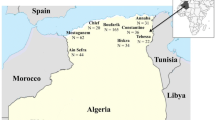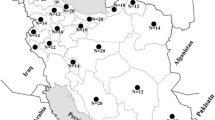Abstract
This study presents the results of the analysis of subspecies of honeybee from Altai krai using SSR loci Ap243, 4a110, A24, A8, A43, A113, A88, Ap049, and A28 and the mtDNA COI–COII locus. It was found that the allelic variant PQQ COI–COII of mtDNA, characteristic of the evolutionary lineage M, prevails in the studied sample of seven districts of Altai krai. Analysis of microsatellite loci showed that a quarter of colonies are of hybrid origin. Despite the fact that we covered only a small part of the population, the results obtained indicate that the dark forest bee has survived in Altai krai.

Similar content being viewed by others
REFERENCES
Ruttner, F., Biogeography and Taxonomy of Honey Bees, Berlin: Springer-Verlag, 1988.
Wallberg, A., Han, F., Wellhagen, G., et al., A worldwide survey of genome sequence variation provides insight into the evolutionary history of the honeybee Apis mellifera, Nat. Genet., 2014, vol. 6, no. 10, pp. 1081—1088.
Momeni, J., Parejo, M., Nielsen, R.O., et al., Authoritative subspecies diagnosis tool for European honey bees based on ancestry informative SNPs, BMC Genomics, 2021, vol. 22, p. 101. https://doi.org/10.1186/s12864-021-07379-7
Jensen, A.B., Palmer, K.A., Boomsma, J.J., and Pedersen, B.V., Varying degrees of Apis mellifera ligustica introgression in protected populations of the black honeybee, Apis mellifera mellifera, in northwest Europe, Mol. Ecol., 2005, vol. 14, pp. 93—106.
Ruottinen, L., Berg, P., Kantanen, J., et al., Status and Conservation of the Nordic Brown Bee: Final Report, NordGen, 2014.
Thompson, C., The health and status of the feral honeybee (Apis mellifera sp.) and Apis mellifera mellifera population of the UK, PhD Thesis, Leeds, 2010.
Ilyasov, R.A., Poskryakov, A.V., Petukhov, A.V., and Nikolenko, A.G., Molecular genetic analysis of five extant reserves of black honeybee Apis melifera melifera in the Urals and the Volga region, Russ. J. Genet., 2016, vol. 52, no. 8, pp. 828—839. https://doi.org/10.1134/S1022795416060053
Bilash, G.D. and Krivtsov, N.I., Selektsiya pchel (Honeybee Breeding), Moscow: Agropromizdat, 1991.
Min’kov, S.G., Excerpts on the history of beekee** in Altai, Pchelovodstvo, 1954, no. 3, pp. 62—64.
Kostenkov, P.P., Sibirskomu pchelovodu (To the Siberian Beekeeper), Barnaul: Vedi, 1992.
Shunk, A.A., Swarming of local Altai bees, Pchelovodstvo, 2008, no. 4, pp. 35—37.
Kaskinova, M.D., Saltykova, E.S., Gaifullina, L.R., et al., Genetic state of the Altai population of dark forest bee Apis mellifera mellifera L., Biomika, 2018, vol. 10, no. 3, pp. 281—285. https://doi.org/10.31301/2221-6197.bmcs.2018-37
Bertrand, B., Alburaki, M., Legout, H., et al., MtDNA COI-COII marker and drone congregation area: an efficient method to establish and monitor honeybee (Apis mellifera L.) conservation centers, Mol. Ecol. Resour., 2015, vol. 15, pp. 673—683. https://doi.org/10.1111/1755-0998.12339
Oleksa, A., Chybicki, I., Tofilski, A., and Burczyk, J., Nuclear and mitochondrial patterns of introgression into native dark bees (Apis mellifera mellifera) in Poland, J. Apic. Res., 2011, vol. 50, no. 2, pp. 116—129. https://doi.org/10.3896/IBRA.1.50.2.03
Chernyshev, S.E., Ecological and morphological features and economic value of honey bees (on the example of Altai krai), Extended Abstract of Cand. Sci. Dissertation, Mosk. S-kh. Akad. im K. A. Timiryazev, Moscow, 1982.
Popelyaev, A.S. and Meshcheryakova, L.A., Biological features of bees and pollen composition of honey in Zmeinogorskii rayon of Altai krai, Agrarnaya nauka—selskomu khoxyaistvu (Agricultural Science to Agriculture) (Proc. XIV Int. Theor. Pract. Conf.), 2019, pp. 199—200.
Meshcheryakova, L.A., Breed characteristics of bees and floristic composition of honey in the apiary from Kalmanskii raion of Altai krai, Vestn. Altai Gos. Agrar. Univ., 2018, no. 6(164), pp. 150—155.
ACKNOWLEDGMENTS
We are grateful to A.A. Shunk, I.N. Chubarov, V.R. Tyagunov, D.V. Nastenko, A.V. Zhabin, A.S. Malik, and D.V. Osinov for providing material and cooperation.
Funding
This work was supported by the Russian Foundation for Basic Research, grant no. 19-54-70002, and also State Assignment AAAA-A21-12011990120-7 using the equipment of the Center of Collective Use Agidel and UNU Kodink, Ufa Federal Research Center, Russian Academy of Sciences.
Author information
Authors and Affiliations
Corresponding author
Ethics declarations
Conflict of interest. The authors declare that they have no conflicts of interest.
Statement on the welfare of animals. All applicable international, national, and/or institutional guidelines for animal care and use have been followed.
Rights and permissions
About this article
Cite this article
Kaskinova, M.D., Gaifullina, L.R., Kinzikeev, A.K. et al. Genetic Structure of the Apis mellifera L. Population from Altai Krai. Russ J Genet 58, 880–883 (2022). https://doi.org/10.1134/S1022795422070092
Received:
Revised:
Accepted:
Published:
Issue Date:
DOI: https://doi.org/10.1134/S1022795422070092




